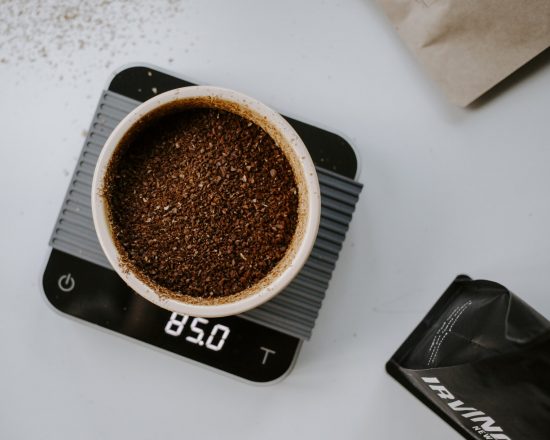
In a recent YouTube video, James Hoffmann addresses the re-popularized method of spraying coffee with water.
BY KATRINA YENTCH
BARISTA MAGAZINE ONLINE
Cover photo by Tyler Nix for Unsplash
As we continue to experiment, innovate, and refine home coffee brewing, we interact that much harder with the geeky, wonderful world of coffee forums—and so, YouTube becomes that much more relevant to our barista lives. One topic that coffee YouTuber James Hoffmann addressed recently is coffee static: those pesky fine grounds that tend to stick to the sides of whatever you grind coffee into. Although this occurrence isn’t super bothersome to me, it did pique my interest when James reintroduced the idea of misting coffee grounds with water to reduce coffee static in my morning cup.
In this video, James Hoffmann mentions that spray bottles have recently accompanied home grinder shipments he has received. With companies sending these, he explains that the intention is to reduce coffee static in the grinds. In order to do this, one would spray their dosed whole-bean coffee with water for every cup of coffee they brew. Measuring out to just .1 of a gram, the added moisture will keep coffee from sticking to the sides of a dosing chamber. As a result, you won’t have to tap your dosing chamber against anything, you use up all the coffee, and you have less of a mess!

What is that, you say? Your spray bottle for watering your plants has two uses now? Not quite. Unlike your standard spray bottle for cleaning and watering, the particles created by this kind of spray bottle are much smaller. You may recognize this kind of bottle as one used for cosmetics or essential oils. (Many YouTube commenters were actually hoping for a coffee essential oil rather than a coffee hack when they saw the thumbnail video for this photo.) With this type of spray bottle, users can expect to cover a much more even surface area when they spritz their coffee beans.
“We initially learnt about the water droplet technique from Home-Barista forum,” says Hayden Lou, business development manager at OPTION-O. The company includes a spray bottle with their Lagom P64 grinders. “We were skeptical at first but after trying that we’re an immediate convert! If reducing static electricity in coffee (grounds) is the goal, it works almost too well for the minimal effort it required!”
The method comes as an evolved form of the RDT Technique, pioneered by David Ross in 2005. The idea involved adding a droplet of water to coffee grounds to reduce static. Eric Mann, owner of LeverCraft Coffee in Austin, Texas, has created a new home grinder called the LeverCraft Ultra, and explains why static happens: “It is a well-known fact that when ‘single dosing’ coffee into a coffee grinder, which is the act of grinding only a single dose of beans, it does not fill up the entire grind chamber, so beans move around a lot more inside of the chamber and create static electricity, which causes coffee to go all over the place.” Eric’s grinder also comes with a fine-mist spray bottle, and his baristas at LeverCraft implement this strategy when they use single-dose grinders.
This method, James acknowledges, comes with some concerns. There are factors to consider, like the brewer’s own environment, a burr’s constant exposure to humidity, and the method’s effectiveness on multiple doses. If the humidity in your space is already at a certain level, the added humidity created by the mist may be too much. Additionally, if you use a grinder in which the dosing and grinding chamber is the same, it may get the grounds too wet. Depending on the grinder model, the whole beans may also stick to different parts of the machine and not end up in the grinder. Lastly, for baristas or users grinding multiple shots, the grinder might end up too wet after enough uses.

So what are companies doing to reduce coffee static in their grinders?
“My point of view, as a message to all grinder manufacturers, is that this is a great little hack,” James says. “But it doesn’t mean you shouldn’t be working on a fix for your grinders more broadly.”
As one commenter suggested, “Why not include ionizers in your grinders?” These would discharge the static of coffee grounds upon contact, and are commonly associated with electronics. However, the ionizer itself would eventually get too caked in grounds. “Sounds like yet ANOTHER thing to break,” another user replied to this. However, La Marzocco did create one product that accounted for this previously, but it reportedly did not catch on in the market.
Another counterargument to consider is the financial effort of what would go into designing something to account for static. “The cost and complication of implementing some kind of other device to handle static will always be many multiples of the cost of a simple $1 bottle and water,” explains Denis Basaric, creator of the Monolith grinder. “To address it in a different manner you would need an additional kind of device that needs to be designed, manufactured, and then finally maintained.” He emphasizes that “simple machines last longer.”
For now, it looks like we don’t have one go-to streamlined method that’s going to solve the problem of static, and that there is not a company utilizing a specific technology advancement to reduce static (to my knowledge at least). Since this hack is so cost-efficient, though, perhaps the method will remain a coffee hack and nothing more. As a home brewer, I gave the RDT Technique a try, and it definitely worked for my pourover!

